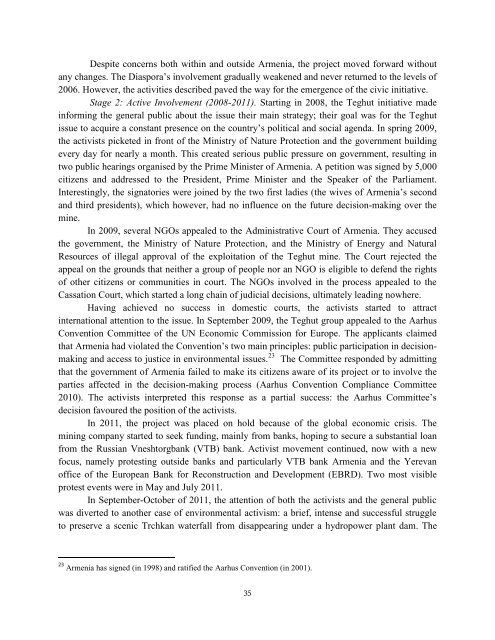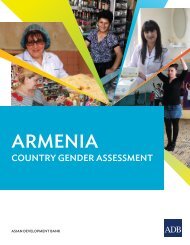Civic Activism as a Novel Component of Armenian Civil Society
English-3
English-3
You also want an ePaper? Increase the reach of your titles
YUMPU automatically turns print PDFs into web optimized ePapers that Google loves.
Despite concerns both within and outside Armenia, the project moved forward without<br />
any changes. The Di<strong>as</strong>pora’s involvement gradually weakened and never returned to the levels <strong>of</strong><br />
2006. However, the activities described paved the way for the emergence <strong>of</strong> the civic initiative.<br />
Stage 2: Active Involvement (2008-2011). Starting in 2008, the Teghut initiative made<br />
informing the general public about the issue their main strategy; their goal w<strong>as</strong> for the Teghut<br />
issue to acquire a constant presence on the country’s political and social agenda. In spring 2009,<br />
the activists picketed in front <strong>of</strong> the Ministry <strong>of</strong> Nature Protection and the government building<br />
every day for nearly a month. This created serious public pressure on government, resulting in<br />
two public hearings organised by the Prime Minister <strong>of</strong> Armenia. A petition w<strong>as</strong> signed by 5,000<br />
citizens and addressed to the President, Prime Minister and the Speaker <strong>of</strong> the Parliament.<br />
Interestingly, the signatories were joined by the two first ladies (the wives <strong>of</strong> Armenia’s second<br />
and third presidents), which however, had no influence on the future decision-making over the<br />
mine.<br />
In 2009, several NGOs appealed to the Administrative Court <strong>of</strong> Armenia. They accused<br />
the government, the Ministry <strong>of</strong> Nature Protection, and the Ministry <strong>of</strong> Energy and Natural<br />
Resources <strong>of</strong> illegal approval <strong>of</strong> the exploitation <strong>of</strong> the Teghut mine. The Court rejected the<br />
appeal on the grounds that neither a group <strong>of</strong> people nor an NGO is eligible to defend the rights<br />
<strong>of</strong> other citizens or communities in court. The NGOs involved in the process appealed to the<br />
C<strong>as</strong>sation Court, which started a long chain <strong>of</strong> judicial decisions, ultimately leading nowhere.<br />
Having achieved no success in domestic courts, the activists started to attract<br />
international attention to the issue. In September 2009, the Teghut group appealed to the Aarhus<br />
Convention Committee <strong>of</strong> the UN Economic Commission for Europe. The applicants claimed<br />
that Armenia had violated the Convention’s two main principles: public participation in decisionmaking<br />
and access to justice in environmental issues. 23 The Committee responded by admitting<br />
that the government <strong>of</strong> Armenia failed to make its citizens aware <strong>of</strong> its project or to involve the<br />
parties affected in the decision-making process (Aarhus Convention Compliance Committee<br />
2010). The activists interpreted this response <strong>as</strong> a partial success: the Aarhus Committee’s<br />
decision favoured the position <strong>of</strong> the activists.<br />
In 2011, the project w<strong>as</strong> placed on hold because <strong>of</strong> the global economic crisis. The<br />
mining company started to seek funding, mainly from banks, hoping to secure a substantial loan<br />
from the Russian Vneshtorgbank (VTB) bank. Activist movement continued, now with a new<br />
focus, namely protesting outside banks and particularly VTB bank Armenia and the Yerevan<br />
<strong>of</strong>fice <strong>of</strong> the European Bank for Reconstruction and Development (EBRD). Two most visible<br />
protest events were in May and July 2011.<br />
In September-October <strong>of</strong> 2011, the attention <strong>of</strong> both the activists and the general public<br />
w<strong>as</strong> diverted to another c<strong>as</strong>e <strong>of</strong> environmental activism: a brief, intense and successful struggle<br />
to preserve a scenic Trchkan waterfall from disappearing under a hydropower plant dam. The<br />
23 Armenia h<strong>as</strong> signed (in 1998) and ratified the Aarhus Convention (in 2001).<br />
35



